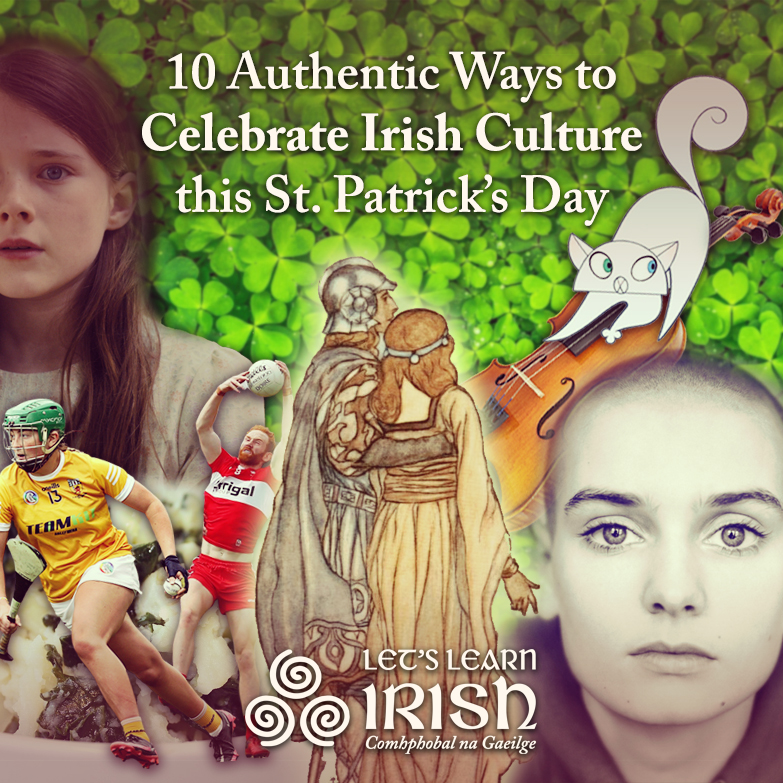Thanksgiving with a Difference – Dinnéar le Difríocht!

This week, on 26 Samhna, we celebrate Thanksgiving in na Stáit Aontaithe Mheiriceá! Many countries and cultures around the world give similar thanks for the autumn harvest with meals and comhrá shared in community with others. Typical meal  in the US? Turcaí, brúitín, súlach, anlann mónóg, agus pióg phuimcín (with generous side helpings of (American) football, 5k Turkey trots, family arguments, and midnight leftovers). This COVID year? We are more likely in lockdown, staying home for a modest feast with our immediate pod. Zoom gloomy, perhaps? And yet, as I’ve learned in my twice-weekly online Irish classes with Let’s Learn Irish, we do find ways to authentically connect across our virtual tábla dinnéir, our dinner table. I’ve written previously about getting started with my Irish classes, how I like learning Irish songs, and how Irish is almost a meditative practice for me. In class, us students are not passing actual mashed potatoes and gravy across the dinner table, but we do share another comfort food – laughter – as we progress through the course. This past week’s lesson? The names for what keeps us satisfied sa bhaile: an cuisneoir, an cithfholcadán, an leaba, agus an leithreas (fíon agus beoir freisin).
in the US? Turcaí, brúitín, súlach, anlann mónóg, agus pióg phuimcín (with generous side helpings of (American) football, 5k Turkey trots, family arguments, and midnight leftovers). This COVID year? We are more likely in lockdown, staying home for a modest feast with our immediate pod. Zoom gloomy, perhaps? And yet, as I’ve learned in my twice-weekly online Irish classes with Let’s Learn Irish, we do find ways to authentically connect across our virtual tábla dinnéir, our dinner table. I’ve written previously about getting started with my Irish classes, how I like learning Irish songs, and how Irish is almost a meditative practice for me. In class, us students are not passing actual mashed potatoes and gravy across the dinner table, but we do share another comfort food – laughter – as we progress through the course. This past week’s lesson? The names for what keeps us satisfied sa bhaile: an cuisneoir, an cithfholcadán, an leaba, agus an leithreas (fíon agus beoir freisin).
Yes, mo ranganna Gaeilge with LetsLearn Irish.com have been saving me these months I’ve stayed at home – purposeful study, incremental accomplishment, and amhráin. But haven’t historians already made the argument that the Irish saved civilization? So why not mise freisin in rural middle Georgia?
 Historians also posit that the Irish saved (American) Thanksgiving. Or at least one American Thanksgiving in February 1631. That winter, the destitute Massachusetts Bay Colony pilgrims were having a hard go of it on Plymouth Rock, subsisting on shellfish and foraged nuts. Hardcore unintentional Paleo diet. The Reverend Thomas Prince wrote in “The Annals of the Year 1631,” “As the winter came on provisions are very scarce, and people necessitated to feed on clams and mussels and ground nuts and acorns, and those were got with much difficulty during the winter season….on February 5th, the very day before the appointed fast, in comes the ship Lion, Mr. William Pierce, master, now arriving at Nantasket laden with provisions. Upon which joyful occasion the day is changed and ordered to be kept (on the 22nd) as a day of Thanksgiving.” You see, a Dublin merchant’s daughter was one of the settlers, and worried for his daughter and her community, he chartered a ship, The Lion, packed it with provisions, and dispatched it to the colony. Buíochas le Dia!
Historians also posit that the Irish saved (American) Thanksgiving. Or at least one American Thanksgiving in February 1631. That winter, the destitute Massachusetts Bay Colony pilgrims were having a hard go of it on Plymouth Rock, subsisting on shellfish and foraged nuts. Hardcore unintentional Paleo diet. The Reverend Thomas Prince wrote in “The Annals of the Year 1631,” “As the winter came on provisions are very scarce, and people necessitated to feed on clams and mussels and ground nuts and acorns, and those were got with much difficulty during the winter season….on February 5th, the very day before the appointed fast, in comes the ship Lion, Mr. William Pierce, master, now arriving at Nantasket laden with provisions. Upon which joyful occasion the day is changed and ordered to be kept (on the 22nd) as a day of Thanksgiving.” You see, a Dublin merchant’s daughter was one of the settlers, and worried for his daughter and her community, he chartered a ship, The Lion, packed it with provisions, and dispatched it to the colony. Buíochas le Dia!
 Yes, the good ship Lion (so named for dauntless courage) transported the material provisions necessary to sustain life, but it also carried with it a most necessary immaterial provision in its cargo – dóchas, or hope! Indeed, with the right provisions, a community can sustain itself and thrive and plan for its future together. We will not forget the brutal history of colonization and its attendant atrocities. But we can also remember this ship of hope.
Yes, the good ship Lion (so named for dauntless courage) transported the material provisions necessary to sustain life, but it also carried with it a most necessary immaterial provision in its cargo – dóchas, or hope! Indeed, with the right provisions, a community can sustain itself and thrive and plan for its future together. We will not forget the brutal history of colonization and its attendant atrocities. But we can also remember this ship of hope.
Keep watch and stay hopeful while we stay at home. It might be a difficult year to summon up gratitude beyond resigned relief – “I survived 2020″. And yet, ní neart go cur le chéile. We sustain our community in our unity of purpose – we stay home this year and celebrate on Zoom, so that next year we may sit down together again for a shared meal and shared blessings. I will always be grateful of my online Irish classes and the virtual community, my closest option until the Gaeilgeoirí pilgrims arrive in middle Georgia and establish ‘Gaeltacht Sheoirsín’. Mar a dear an seanfhocal, “Is buí le bocht an beagan” – the poor are thankful for the little things. Sláinte chugat agus go mbeannaí Dia duit…agus Lá Altaithe Sona Daoibh/Happy Thanksgiving!
Join me next time, as I write about Lá an Dreoilín, the Wren Day that takes place in Ireland on December 26th!
Join the online Irish community for cúrsaí, comhrá & ceardlanna, and follow along on social media @LetsLearnIrish – beidh fáilte romhat!





